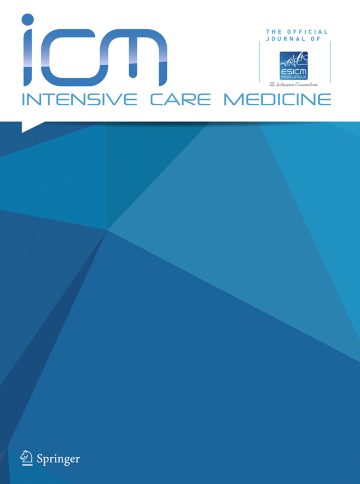如何在重症监护室进行膈肌超声检查
IF 27.1
1区 医学
Q1 CRITICAL CARE MEDICINE
引用次数: 0
摘要
膈肌是一块薄薄的圆顶形肌肉,由肋部和嵴部以及一条不收缩的中央腱组成。肌纤维的激活会使附着区的膈肌缩短变厚,使穹隆向尾部移动。膈肌功能被定义为收缩和产生压力的能力,具有很大的储备能力。然而,临床上明显的膈肌无力(即膈肌产生压力的能力明显减弱)是导致呼吸衰竭而入住重症监护室(ICU)的一个罕见原因。膈肌无力更常见于重症患者,甚至在重症监护室住院的早期就会出现。其病理生理学尚未完全清楚,废用和炎症被认为是关键的风险因素[1]。危重症相关的膈肌无力可能会使断奶复杂化并恶化预后[2]。因此,在特定的临床环境中,对重症监护病房中的膈肌功能进行评估非常重要。超声波可在床边无创观察膈肌的功能和活动。本文将介绍我们在日常护理中使用横膈膜超声的临床经验。本文章由计算机程序翻译,如有差异,请以英文原文为准。

How I perform diaphragmatic ultrasound in the intensive care unit
The diaphragm is a thin, dome-shaped muscle, comprising a costal and crural part, and a non-contracting central tendon. Muscle fiber activation shortens and thickens the diaphragm in the zone of apposition, moving the dome caudally. Diaphragm function, defined as the ability to contract and generate pressure, has substantial reserve capacity. However, clinically significant diaphragm weakness, a marked reduction in its force-generating ability, is an uncommon reason of respiratory failure causing admission to the intensive care unit (ICU). It more commonly develops in critically ill patients, even early during their ICU stay. The pathophysiology hereof remains incompletely understood, with disuse and inflammation recognized as key risk factors [1]. Critical illness-associated diaphragm weakness may complicate weaning and worsen outcomes [2]. Therefore, in specific clinical settings, evaluation of diaphragm function in the ICU is important. Ultrasound allows to noninvasively visualize the diaphragm function and activity at the bedside. In this article, we present our clinical experience with diaphragm ultrasound in daily care.
求助全文
通过发布文献求助,成功后即可免费获取论文全文。
去求助
来源期刊

Intensive Care Medicine
医学-危重病医学
CiteScore
51.50
自引率
2.80%
发文量
326
审稿时长
1 months
期刊介绍:
Intensive Care Medicine is the premier publication platform fostering the communication and exchange of cutting-edge research and ideas within the field of intensive care medicine on a comprehensive scale. Catering to professionals involved in intensive medical care, including intensivists, medical specialists, nurses, and other healthcare professionals, ICM stands as the official journal of The European Society of Intensive Care Medicine. ICM is dedicated to advancing the understanding and practice of intensive care medicine among professionals in Europe and beyond. The journal provides a robust platform for disseminating current research findings and innovative ideas in intensive care medicine. Content published in Intensive Care Medicine encompasses a wide range, including review articles, original research papers, letters, reviews, debates, and more.
 求助内容:
求助内容: 应助结果提醒方式:
应助结果提醒方式:


